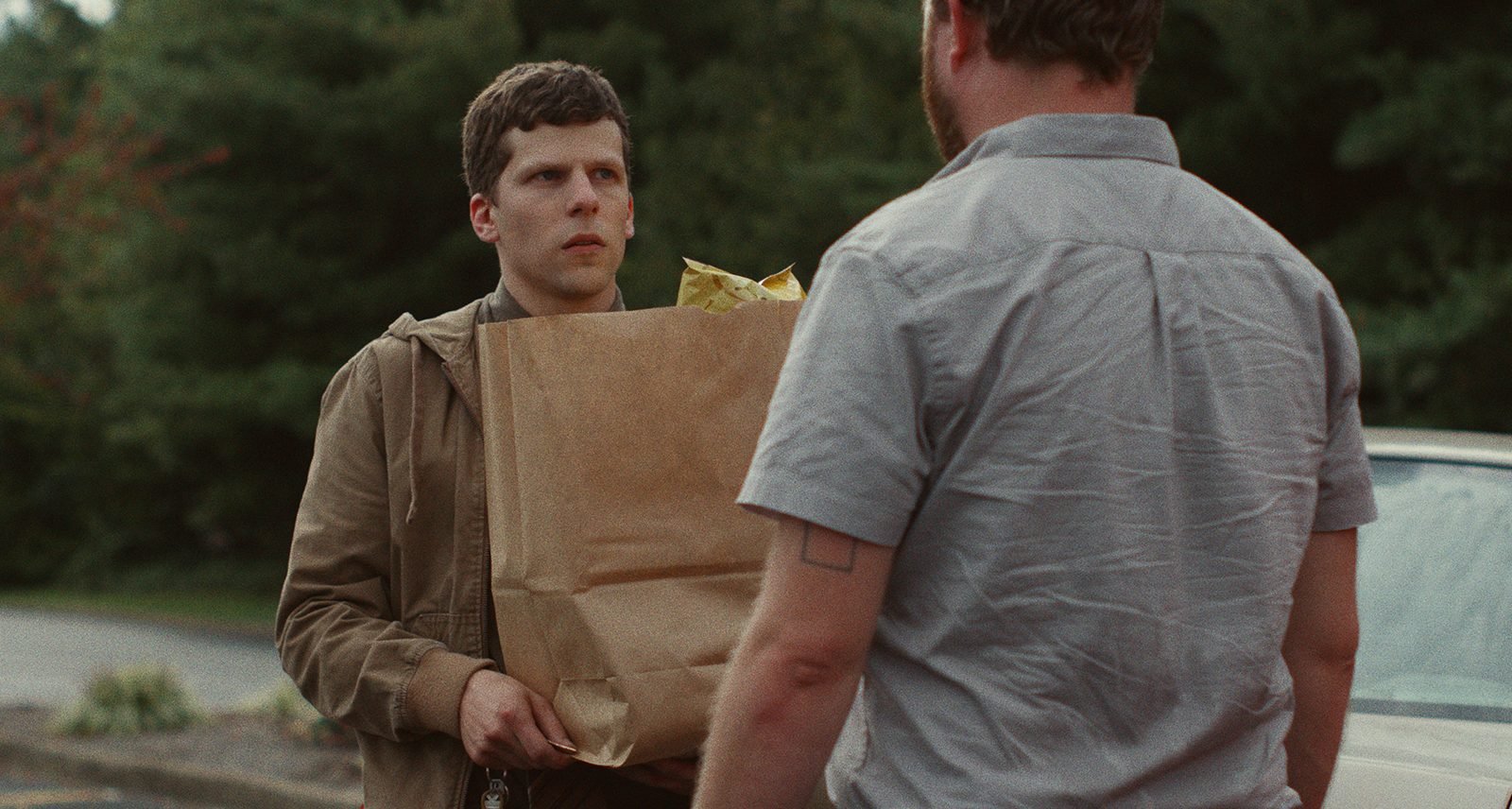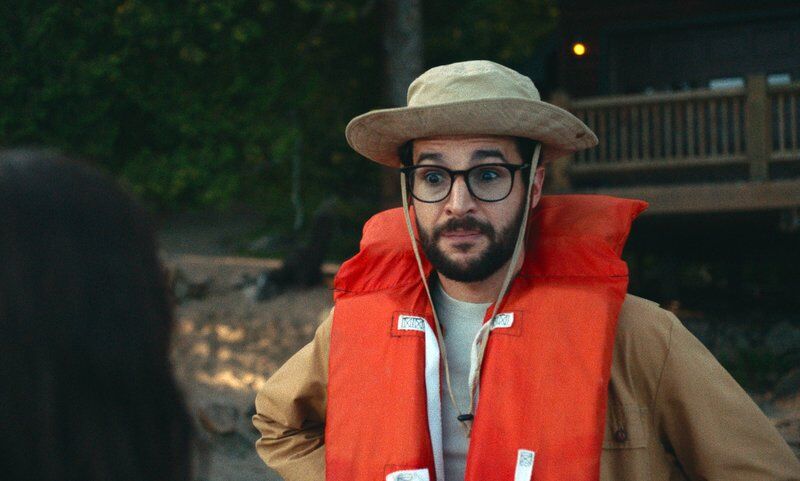I am currently in an ultra-foul mood. Just chuck things out a window sort of mad kind of mood. Does this have anything to do with The Art of Self Defense – NO! So stop asking!! Did I hate The Art of Self Defense?! ABSOLUTELY NOT. In fact, I absolutely loved the film, and if you keep bothering me right now, I may very well snap your femur and drop you into an incinerator for giggles. Ok? Gah!
Seriously though, The Art of Self Defense has got to be one of the most underrated movies of the year. Heck, decade. What am I talking about? The millennium! And I was certain this would have to be Jessie Eisenberg’s lowest grossing film, but TOTALLY forgot that he was in Night Moves for the love! hahaha. This film is written and directed by Riley Stearns, the auteur who brought us the BRILLIANT mindjob that was Faults. I cannot say enough about that film. So, the fact that this movie is in his corpus is just a HUGE indication that we are going to enjoy this film.
But what is this crazy, under-loved, movie all about? Thanks for asking random interwebs denizen! So glad you asked. This movie is as if Napoleon Dynamite and Fight Club had a love child. Yes. I just combined two of the most fundamentally different and fundamentally juxtaposed movies of all time, and smashed them together into a single, and gloriously technicolored creation. A movie that walks us through Casey Davies’ (Jessie Eisenberg of End of the Tour and Night Moves (oh yeah, and that little movie called The Social Network – or something.)) ultra-socially awkward life as an accountant. He doesn’t fit in at work – heck, he doesn’t fit in within this world. He is awkward and intimidated everywhere he goes. And it tells the story of his sudden decision to begin adroitly navigating the chaos of this world.
I literally cannot say anything more clever than “Napoleon Dynamite + Fight Club = The Art of Self-Defense.” Literally nothing more can be said about this movie that will get you to see this film. If your first instinct is – what a horrendously awful idea, then this movie is not for you. Because that is EXACTLY what this movie is. 100%. But, if you loved Napoleon, and you loved Fight Club – I promise you, this unholy hellspawn of a creation is for you.
The Art of Self Defense Walkthrough
Alright, in order to be all on the same page – let’s do a walkthrough of the what, before we can start talking about the why. After being attacked by an evil band of motorcyclists, Casey Davis decides he needs something to help him man up. A gun is his first choice until he joins a Karate club (Clan? Sept? Fraternity? Family? I literally have no idea.) in order to help him become less horrifyingly awkward. Dojo! They are called dojos! hahah. I should probably fix that…nah. Anyway, at the dojo, his Sensei convinces Casey that this is the place for him. Casey meets Anna, (played by Imogen Poots, of the GLORIOUSLY underrated Green Room, as well as one of my all time favorites Knight of Cups.) a brown belt, who teaches all the children’s classes, and has been hit by a glass ceiling at the studio. And Henry, a blue belt at the studio, befriends Casey, and the three make for an interesting trio.
In time, Casey starts learning and getting better. He even earns a yellow belt. And when Casey is invited to the class’ night classes, he is celebrated as the first yellow to make it to that vaunted position. Henry comes to the class sans invite – and Sensei breaks his elbow and tells him never to come back. And with that, we start to realize that something really strange might be going on here. Later, Anna spars with Thomas and beats him within an inch of his life. Thomas, who had just gotten promoted past Anna, into black belt, thought he was better than Anna, and Anna had decided to never hold back again.
Casey begins finding his niche at the studio, and also is encouraged to take on more masculine activities (heavy metal, get a manlier dog, and generally taking on a more alpha mentality. After an elongated absence from work, Casey returns, and is a totally changed person. His annoyingly cocky co-workers are shocked at his change. But after throat-punching his boss, he losses his job. But soon after, Sensei hires him as the studio’s accountant. And when he tells Sensei that he is only taking the classes because of the attack, Sensei invites him out to get revenge after spotting one of the members of the bike gang at a bar. Casey ends up injuring the man, even though he is doubtful this is one of the men who attacked him. But when he realizes Sensei had recorded the encounter, he knows he’s now trapped at the studio.
Later, at the night class, the Sensei tells Casey that they are all going out to ride motorcycles. And that is when he realizes that the group that attacked him originally was the Sensei’s group from the dojo. While out, Sensei orders Casey to attack innocent people walking on the street. But when Anna and Casey attack an undercover police officer, Anna is shot in the leg, and Casey kills the policeman. When Casey and Anna arrive at his apartment, he finds a German Shepherd at his home, given to him by Sensei, after someone at the studio murdered his dachshund.
Casey though, sneaks back into the dojo and finds a working crematorium.
I’m just going to leave that sentence right there for a minute – and just let you bask in the brilliance of it. Yes, I said a crematorium. He finds a furnace for burning bodies. HAHAHAHa. Come on. Riley Stearns needs a screenplay Oscar just for that tidbit alone. What is there a crematorium in a dojo for? Well, we already know that the Sensei is up to all manner of no good. We watched him break a student’s elbow, and force students into attacking innocent people on the street. A human incinerator just seems like the next logical step. Casey also finds a hit-list, a pile of videos that the Sensei is using to bribe his own students into doing what he wants them to do. He also finds Henry hanging from the rafters having committed suicide. But possibly the biggest thing that Casey learned was that Anna prevented her classmates from murdering Casey during his attack.
When the Sensei returns in the morning, Casey challenges him to a duel to the death. Suited, and ready to go, the two turn and face each other. And as soon as they go to fight, Casey pulls a gun out his shirt and shoots Sensei dead. And as the movie comes to a close, at the evening class, Casey informs the other students that he killed Sensei in a duel by punching his pointer finger through his skull. Casey discovers then that Thomas is the one that killed his dachshund, after siccing his new dog on him and finding bite marks on his arm. Anna is promoted to black belt, which means she is the senior member of the dojo, and assumes her role as the dojo’s Sensei. She then begins sharing her philosophy against ruthless aggression and instead instills an idea of compassionate combat. And finally, Casey is promoted to the children’s teacher in Anna’s place. Drop curtain.
What Was Riley Stearns Doing??
I love wonkie, strange movies like this one. The movie that most comes to mind that is like this one – that is just too strange and thoroughly quirky is I Don’t Feel at Home in this World Anymore. And similarly, it feels as though Stearns is up to something different here because of Casey’s unexpected character arc. Normally he would lose, in the school of Karate Kid, or Rocky, and then tirelessly work in order to compassionately, and with humility, overcome this enormous obstacle that was in his way. But, obviously, Stearns is not doing this at all. This isn’t a sports story forged in the likeness of Rocky – which was written by Sylvester Stallone over 40 years ago, and has defined all sports movies ever since. To that end, I found a great interview with Stearns where he talks about his feelings and goals about this movie of his.
“Somebody who’s an underdog and trains and works hard and eventually overcomes, or in the process of trying to overcome loses but ultimately gains more in their loss than they would have in their win. I didn’t want that to happen in the same way. I wanted a movie that started off in that vein, then as it went along, essentially halfway through the film I wanted the rug to be pulled out from under you and you be woken up in a way that you thought you knew what was going to happen, and you have no idea.”
So he’s got us on our back foot, totally unclear the what or the why as to where this film is going to be going. What could his goal, or message, possibly be? So I started trying to work out what the deeper meanings here might be. It’s clear that Casey’s path is to take the learning’s of his Sensei, and to use them to overthrow the man who originally belittled him violently. It’s almost like Casey takes on the darkness, and its methods, in order to overthrow the overthrowers. It’s as if Casey uses the methods of the evil in order to stop the chaos, and to restore order. It’d be like if we went into the Middle East and began unleashing suicide bombers, and car bombs, in order to win back peace in the region. (Or something like that. It’s a stupid analogy.) But ultimately we see that Casey may use evil means, but we finally see that his reasons are good, and that it is for a greater purpose. His evil ends make up for themselves – redemption via peace restored. So I went looking to see if there was a deeper insight to be gained and found this quote from Stearns that made me do a little dance, that I was pretty spot on with where he was going:
“Along the way…he takes on the bully aspect. He’s trying to come to the teachings of Sensei and most of those are very, very bad teachings, very overtly horrible things that he’s embracing. I think even in a spoilery sense, even in the way that he kind of overcomes at the end, it’s him embracing a little bit of that darkness that he’s gathered along the way for the greater good. In my opinion, Casey may make some decisions in the way that he solves his problems that’s almost like a self-sacrifice. I’m doing this because I have to, so nobody else has to go through with it, or so nobody else has to deal with it in the future. For him, I think it’s all about you honor the dojo, which is so funny to say in an interview, but he’s really looking for the honor of the dojo and really concerned about that. He’s willing to sacrifice his own morality for the greater good. That’s what was important for me. That was something I definitely wanted to do.”
“He’s willing to sacrifice is own morality for the greater good.” It’s a truly horrifying philosophical or theological ideal. It’s as if, in World War II, we took the Just War theory, and threw it out the window, in order to do whatever we had to so that we could finish the war. And maybe we did do that with the bombing of Nagasaki and Hiroshima? The fire bombing of Dresden is another well trod playground for Philosophy 101 students. But what if we had the capability, and we decided to Nuke Germany into a barren wasteland? The innocent people, the elderly, the infirm, everyone? Would we have been justified in our immoralities? That is what Stearns is positing here.
A Discussion About Toxic Masculinity
Don’t get me wrong, I loved the movie. I loved the head fake, and the dashing of the standard plotlines and film structures that we are used to seeing. But to follow that logic all the way down to its logical conclusion seems like something of a really bad digression. But, instead of looking at it from the sense of perspective of morality, what if the movie more fits as a dialogue about toxic masculinity run amok? Sensei is obviously an over-the-top representation of masculinity that is turned up to eleven. AND suddenly, we are talking about something else entirely.
I find it funny how many men today find their masculinity, and their place as the Alpha, at risk. And to see this as a counter to that sort of perspective actually clicks all the pieces into place for me. But Stearns definitely disagrees with this perspective – at least in all the interviews I have found on this topic. I have enjoyed finding myself regularly on a side of the argument that disagrees with the creator of the film. And best, I enjoy telling them so! hahah.
But whether you just enjoy this movie for the quirky weirdness of Jesse Eisenberg’s performance, or the cleverly different screenplay, the direction, I think we can agree that this is an out of the box mindjob of a movie. And if you didn’t like it – I definitely can recommend a few other websites where you would be more welcome! hahah.
Edited by: CY



